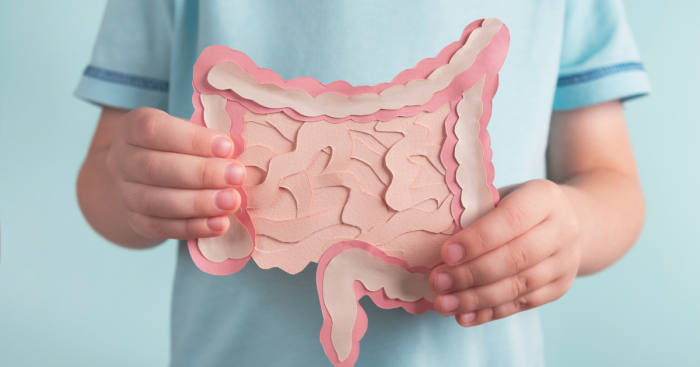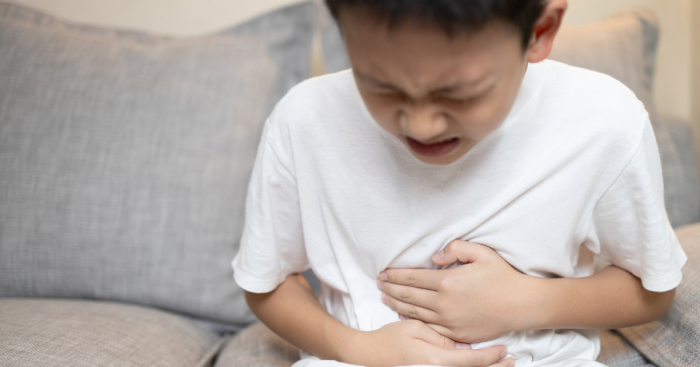Constipation in children is common. Although it is generally not a serious condition[1], constipation is serious enough for the child who is experiencing discomfort, distress, pain and even fear of having a bowel movement.
A child who is having the condition will have infrequent bowel movements and may exhibit a series of abnormal behaviour. They include irritability, crying bouts, aggression, temper tantrums, disrupted sleep, straining and withholding behaviour.
What is constipation
Constipation affects people of all ages, not just children. However, it seems to be a common occurrence in children during the toilet training phase, or when they are facing a change in their routine or environment or when they start going to school. Generally speaking, constipation is a gastrointestinal problem where you are unable to pass motion or completely empty the bowels due to the stools being too hard and too large to pass through the anus. Sometimes the stools may be small, lumpy and dry. Chronic constipation may lead to complications or signal an underlying condition.
Such conditions[2] may include:
- Problems with the intestinal tract, rectum or anus
- Nervous system problems such as cerebral palsy, spina bifida
- Endocrine problems such as hypothyroidism
- Certain medications such as iron supplements or certain antacids
How Constipation Affects your Child

A child who is constipated[3]:
- Will have fewer than three bowel movements a week. Although the frequency of bowel movements is different for each child, if the child has less bowel movements than what is normal, then it means that there is a problem.
- Passes stools that are hard and sometimes large.
- Experiences difficulty and pain when passing motion.
- Unable to pass motion.
- Blood on the surface of hard stools.
Other less obvious symptoms[4] include:
- Stomach pain
- Bloating
- Nausea
- Lethargy
- Irritability
- Poor appetite
- Standing on tiptoe and rocking back and forth, gritting the teeth, clenching the buttocks or doing unusual dance-like movements in an attempt to stop having a bowel movement
- Soiled underwear from liquid or pasty stool
- Daytime or nighttime wetting
What Happens During Digestion

To understand how constipation occurs, here is a run-down about what happen in the digestive tract after we eat. When food goes into the stomach, it gets mixed with the various digestive juices secreted by the various organs such as the liver, gallbladder and pancreas[5]. This turns the food into a liquid paste which is then moved by the digestive system’s muscular contractions into the small intestines. It is further broken down and liquefied to allow its nutrients to be absorbed into the blood stream. What remains is undigestible fibre and food particles which then goes into the large intestines (or colon) where further liquid absorption takes place and where the stool is eventually evacuated through the rectum (the lowest part of the colon that leads to the anus).
Constipation and Possible Complications
If your child has constipation, it could be due to the colon’s contractions being too slow and sluggish to move waste along. As the colon will continue to absorb liquid, the slow movement leads to too much water being absorbed from the stool. This makes the stools hard, dry and compacted. The slower the food moves through the digestive tract, the more water the colon absorbs, and the harder the stools become, resulting in constipation.
Why the colon may be slow to move stool along may be due to factors such as diet, a lack of exercise and insufficient liquid intake.
Once a child becomes constipated, the problem can quickly get worse if not resolved as soon as possible. The child may stop going to toilet because it hurts too much but by withholding the stools to avoid going to the toilet, the colon may distend and lose its sense that stool is there and needs evacuation. This causes further build-up and back-up in the rectum causing it to lose control over bowel movements. Other vicious-cycle complications include:
Constipation can tear the skin around the rectum and anus when the child finally passes the large, rocky faeces. Anal fissures[6] can cause the skin around the anus to bleed. Blood loss is usually minimal but the anus will feel raw and painful, making the child fearful of having another bowel movement.
Did you know that constipation can cause diarrhoea? This is called encopresis[8] or faecal incontinence. Encopresis[9] is actually diarrhoea from bowel overflow. It happens when too much impacted stool clogs up the colon and rectum causing liquid stool to leak out around the clog, staining underwear and clothes. Not only does this cause embarrassment to the child and parent because it happens involuntarily, encopresis[10] can also be very alarming as it can look like diarrhoea caused by infections. However, it is actually the child’s body trying to evacuate the large amount of backed up stool. Encopresis[11] usually happens to children after the age of four, after they have been toilet trained.
Faecal streaking[12] happens when the child is already constipated and has backed up stool but has not yet reached the point of encopresis. When the child has flatulence, some of the stool is passed out causing streaks or chunks of faeces to smear the underwear.
Hemorrhoids[13] in toddlers are rare but they can happen and constipation is a common cause. Hemorrhoids are swollen veins in the rectum and anus that stay inside or are pushed outside of the anus. They may be painful or itchy and may cause rectal bleeding and appear as small reddish or bluish bumps around the edge of the anus. Hemorrhoids develop when the child is constantly straining and putting too much pressure on the veins at the rectum. It can also happen when they sit too long on the toilet trying to have a bowel movement.
Causes and Cures of Constipation in Children

As mentioned above, there are many reasons why a child may become constipated. The following are some of the more common causes[14]:
- Eating a Diet low in Fibre
Constipation can occur when a child is eating too much food that is high in fat and starch and low in fibre. These foods include fast foods, junk food with high salt content such as crisps, chips and all those kerepek and keropok, gluten-containing foods like cakes, breads, kueh and biscuits, processed grains made with white four including flat breads (such as roti canai, yau char kuay, ham cheem beng), white bread, noodles and white rice and deep-fried meats and poultry.
Constipation may occur during a diet change such as when babies start weaning and transitioning to solid foods. This is because their digestive system is learning to manage solid food for the first time.
Dehydration is a common cause of constipation. When a child is not drinking enough plain water and other fluids, their intestines are unable to add enough water to the stools. This results in hard, dry, lumpy stools that are difficult to pass. Toddlers aged from two to five years should drink one to five cups of plain water a day, not inclusive of two to three cups of other fluids such as milk.
Leading a sedentary lifestyle such as being glued to the TV or playing video games and not getting enough exercise. Movement and activity help move digested food through the intestines.
- Emotional Issues and Power Struggles
Children may hold their bowel movements because they don’t want to use public bathrooms, or when they are feeling stressed and anxious because of school, friends or family. They may also hold their bowel movements on purpose when they are having power struggles with their parents.
Many children experience constipation during toilet training. Typically, toilet training begins at around the age of two. Learning to come out of diapers and using the toilet for the first time is a huge step for toddlers and understandably, this can cause a great deal of anxiety and stress for the child who may be pressured to poop or who may be afraid of letting go “a part of” himself or herself into the potty. As a consequence, they may withhold their stools to avoid going to the toilet altogether. This leads to constipation.
Some children don’t pay attention to their bodily cues such as when they need to have a bowel movement. They are so busy playing they would rather ignore or withhold and continue playing than stop to go to the toilet. Constipation can also happen when they start a new routine, like starting kindergarten or school. They can’t go to the toilet whenever they feel the need and have to change their bowel routine.
How to Prevent or Treat Constipation

1: Encourage eating fibre-rich food such as fruits and vegetables as well as whole grains. These foods provide roughage to keep the digestive tract moving at a steady pace.
2: Dried fruits such as raisins, dried apricots or prunes contain more fibre than fresh fruits. Eating them can help relieve constipation. Prune juice is also just as effective at improving bowel movements.
3: Drink more plain water and stay hydrated, especially in our hot and humid Malaysian weather. Sweating without replenishing the body’s lost water can cause constipation[15].
4: Drinking a cup of warm water can help start bowel movements.
5: If the child is on formula milk, look at the ingredients for the addition of Galacto-oligosaccharides (GOS). It is a prebiotic that stimulates the growth of beneficial bacteria[16] such as Bifidobacteria and Lctobacilli in the intestinal tract while it reduces the number of harmful bacteria. A rich intestinal flora (or gut microbiota) has been linked to a strong immune system. Furthermore, GOS has been found in numerous studies to improve bowel function by softening the stools, reducing stool pH while increasing stool frequency. Therefore, GOS has also been found to be effective at alleviating constipation in children[17].
6: Getting your child to exercise can help with constipation. Exercise improves digestion because boy movement helps the intestines push food along. Get your child to go outside to run and play. The sunshine and fresh air will freshen the mind, strengthen his lungs and help his body make Vitamin D[18] – the component needed by the body to absorb calcium in order to build strong bones.
7: If your child is unable to pass a stool, apply petroleum jelly such as Vaseline around the anus to help smoothen the passage. The lubrication will ease the pain. If he has anal fissures, dab diaper cream to help the healing process.
8: If the child is having constipation because of potty training, do not scold or pressure him to produce stools on demand. Instead, make toilet training fun, give him lots of praise, instil a non-food reward such as a gold star for every time he has a successful evacuation in the toilet, or hold off toilet training for a while and let him continue wearing diapers until a later date when he is more ready.




